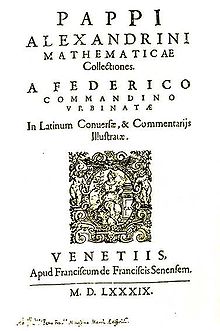Pappos

Pappos ( Greek Πάππος ὁ Ἀλεξανδρεύς Páppos ho Alexandreús , Latinized Pappus Alexandrinus or Pappus , also Pappos of Alexandria ) was a Greek mathematician and astronomer . He lived in Alexandria in the 4th century and was one of the last great mathematicians of the ancient world .
Life
It is certain that Pappos observed a solar eclipse in Alexandria on October 18, 320. Since he does not mention later solar eclipses, he was probably no longer scientifically active at the time of Emperor Theodosius I (379–395), but it is possible that he still lived through this period, as the Suda , a Byzantine encyclopedia from 970, did describes. According to a note in a 10th century manuscript, however, he lived under Emperor Diocletian (284–305).
Mathematical collections
His main work are the Mathematical Collections (Latin Mathematicae Collectiones ), which are a main source of our knowledge of geometry in antiquity. Essentially, it is a commented collection of older results supplemented by our own findings. It contains, among other things, sentences about double ratios , involutions , conic sections , the scope of which was only recognized much later; also by the Jesuit Guldin discovered anew Zentrobarische rule (now Guldinsche rules ) for determining the content and the surface of bodies of revolution there is already there. Of the eight books in the Mathematical Collections , only the six last and the end of the second book are still handwritten.
Other works
In addition to the collections Pappos wrote commentaries on various older works, so to Euclid's Elements or Almagest of Ptolemy . He also wrote a geography and it is believed that the geography of Moses of Choren is largely an Armenian translation of it. Part of Porphyrios' commentary on the theory of harmony by Claudius Ptolemy may have come from Pappos .
Sentences of Pappos
Among the various geometric theorems that can be traced back to Pappos, the so-called Pappos-Pascal theorem is of particular importance in modern geometry , which states that in a hexagon whose corners lie alternately on two different straight lines, the intersection points of the opposite sides are collinear .
The so-called area formula of Pappus (also the (area) theorem of Pappos) goes back to Pappos, which generalizes the theorem of Pythagoras to arbitrary triangles and parallelograms.
reception
The first Latin edition of the Mathematical Collection of Pappos comes from Federico Commandino (Pesaro 1588, 1602, Venice 1589, 2nd edition Bologna 1660). An exception was the then unknown fragment of Book 2, which John Wallis found in the Savilian Library in Oxford and whose translation he published in 1688.
See also
Text output
- Friedrich Hultsch (Ed.): Pappi Alexandrini Collectionis , 3 volumes, Berlin 1876 to 1878 (Greek and Latin)
- Paul ver Eecke : Pappus d'Alexandrie, La Collection Mathématique , 2 volumes, Paris, Bruges 1933 (French translation)
- Carl Immanuel Gerhardt : The Collection of the Pappus of Alexandria, Greek and German , 2 volumes, Halle 1871 (and Eisleben 1875)
- Alexander Jones (Ed.): Mathematical Collections, Book 7 , Springer, 1986 (Greek and English)
- Heike Sefrin-Weis (Ed.): Pappus of Alexandria: Book 4 of the Collection , Springer, 2010
- Adolphe Rome (ed.): Commentaires de Pappus et de Théon d 'Alexandrie sur l' Almageste , Volume 1, Biblioteca Apostolica Vaticana, Rome 1931
- William Thomson, Gustav Junge (Ed.): The commentary of Pappus on Book X of Euclid's Elements , Cambridge (Massachusetts) 1930, pp. 189–260 (Arabic and English)
- Heinrich Suter : The Commentary of Pappus on the X Book of the Euclid , 1922, pp. 9–78 (German translation)
- Arsène Soukry: Geographie de Moïse de Corène d'après Ptolémée. Texts arménien traduit en français , Venice 1881
literature
- Hans-Joachim Waschkies : Pappos from Alexandria. In: Hellmut Flashar (ed.): Outline of the history of philosophy . The philosophy of antiquity , Volume 2/1, Schwabe, Basel 1998, ISBN 3-7965-1036-1 , pp. 406-410
- Richard Goulet: Pappus d'Alexandrie . In: Richard Goulet (ed.): Dictionnaire des philosophes antiques , Vol. 5, Part 1, CNRS Éditions, Paris 2012, ISBN 978-2-271-07335-8 , pp. 147-149
- Ivor Bulmer-Thomas : Pappus of Alexandria . In: Charles Coulston Gillispie (Ed.): Dictionary of Scientific Biography . tape 10 : SG Navashin - W. Piso . Charles Scribner's Sons, New York 1974, p. 293-304 .
- Thomas Heath : History of Greek Mathematics , Volume 2, Oxford 1921
- Serafina Cuomo : Pappus of Alexandria and the Mathematics of Late Antiquity , Cambridge University Press 2000
Web links
- Literature by and about Pappos in the catalog of the German National Library
- Pappos (Bibliotheca Augustana)
- John J. O'Connor, Edmund F. Robertson : Pappus of Alexandria. In: MacTutor History of Mathematics archive .
- Spektrum .de: Pappos of Alexandria (around 320) November 1st, 2016
| personal data | |
|---|---|
| SURNAME | Pappos |
| ALTERNATIVE NAMES | Pappus, Pappos of Alexandria |
| BRIEF DESCRIPTION | Greek mathematician |
| DATE OF BIRTH | 3rd century or 4th century |
| PLACE OF BIRTH | Alexandria |
| DATE OF DEATH | 4th century or 5th century |
